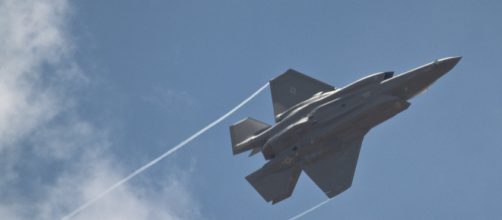The F-35 Lightning II stealth fighter, the Lockheed Martin-built fifth-generation aircraft, is about to get a major weapon upgrade, thanks to the ongoing effort by the USAF's Air Force Research Lab and the US Navy’s Office of Naval Research. The high-tech plane is set to receive a huge laser boost as well as a major electronic warfare upgrade.
According to Fox News, the US Air Force Research Lab and Office of Naval Research are working on a new laser weapon system that can be used by the US military forces in a future conflict. The new weapon system is expected to bring new air attack options as well as new defensive capabilities.
The planned upgrade will also make the F-35 a more lethal attack platform, providing the USAF with much faster, more precise and quiet attack advantage against enemy targets.
The US military currently has three F-35 models, the F-35A, the smallest and lightest F-35 version. This conventional takeoff and landing (CTOL) aircraft is the only variant equipped with a 25 mm GAU -22/A internal cannon. The Marine Corps F-35B is a short takeoff and vertical landing (STOVL) aircraft, designed for Marine Corps’ light aircraft carriers. The US Navy’s F-35C, is a carrier-based, catapult takeoff but arrested recovery (CATOBAR) variant of the F-35 aircraft. Unlike the US Air Force and Marine Corps variants, the carrier-based F-35C features much larger wings and tail control surfaces.
The Air Force and Navy start working on a new laser weapon system
The Air Force Research Lab and the Navy’s Office of Naval Research have already performed live testing of the laser prototype. The USAF wants a new laser platform that can be used as a ground-based weapon system or as a part of a new air attack weapon. The planned laser weapon system is expected to provide the service with additional technology chops and advantage on future clash with rivals.
It's not just the US Air Force, the US Navy is also on the hunt for their next big weapon system. The US Navy is reportedly working on a new laser weapon for the Marine Corps’ short take-off and vertical-landing F-35B aircraft. The F-35B was the first of the three F-35 main models to enter the US military service.
The plane is expected to serve with the US Marine Corps until 2070.
Works on the new laser application are already being planned for next year at the Navy’s new 16,000-square-foot facility. The new F-35 facility will be hosting the development stage of the new laser weapon system, according to Matthew Crisp, Head of F-35 Joint Program Office at Fleet Readiness Center East in Marine Corps Air Station Cherry Point, North Carolina. The Navy also added that the workload of the new laser application will include both the F-35B and F-35C models. It will also include some F-35 aircraft owned by US allies or partner countries. The Navy’s Fleet Readiness Center East will work on the Marine Corps variant (F-35B), while the USAF’s Ogden Air Force base in Utah will handle the laser works on the F-35C models.
The aircraft gets a huge electronic warfare upgrade
In addition to the new laser weapon, the Lockheed Martin-built aircraft will also receive a major electronics warfare upgrade, courtesy of BAE Systems. The planned weapon upgrade is expected to give the stealth aircraft with more effective electronic countermeasures.
For the huge electronic warfare (EW) upgrade, Lockheed Martin, the company that designed the F-35 aircraft, has selected BAE Systems to develop and deliver the package of EW upgrades under the Block 4 program, a multi-year design and development works that will add 11 new upgrades to the F-35’s electronic warfare and countermeasure systems.
The UK-based defense and aerospace company has been selected by Lockheed Martin to beef up the aircraft’s EW capability.
The British firm is no longer stranger with the F-35 weapon development program. The company has developed the original ASQ-239 electronic warfare/countermeasures subsystem for the F-35 aircraft and has been working for the F-35 program for the past 14 years. The company will upgrade ASQ-239, adding more advanced flares and chaffs, according to Aviation Week
The Block 4 program will be developed at three BAE Systems facilities in Nashua, Southern New Hampshire. More than 1,500 workers are expected to join and work on the new Block 4 program. The contract will also preserve the role of BAE Systems’ Nashua facility as the sole electronic warfare system supplier for the US Air Force’s most advanced and most lethal combat planes. These are the Lockheed Martin F-22 Raptor, the Lockheed Martin F-35 Lightning II and the upcoming Northrop Grumman B-21 stealth bomber.


